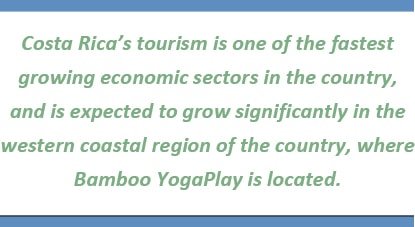Share This
[addtoany]

Industry Analysis
This section is an analysis of the industries in which the Company operates. Furthermore, information regarding
industry participants, general trends and regulatory and economic factors are presented.
INDUSTRY OVERVIEW

Bamboo YogaPlay is categorized as part of the tourism industry
in Costa Rica, more specifically, the accommodation and food
services sector of the tourism industry. Costa Rica’s tourism is
one of the fastest growing economic sectors in the country, and
is expected to grow significantly in the western coastal region of
the country, where Bamboo YogaPlay is located.
The following table provides an overview of the accommodation and food services sector in Costa Rica:

COSTA RICA TOURISM INDUSTRY
Industry Size
Costa Rica is the most visited country in the Central American region, earning $2.2 billion per year from tourism. It
brought in over two million foreign visitors in 2008, about 436 visitors per thousand inhabitants. Most of its
visitors come from the United States and Europe. Following not far behind are Costa Rica’s neighboring countries
in Central America such as Nicaragua. Revenues from North America and European travelers alone created
expenditures of just over $1,000 per tourist in 2008.
There are 499 hotels located throughout Costa Rica. In the region of Puntarenas, where Bamboo YogaPlay is
located, there are 90 hotels.4
History & Geography
Beginning 1987 tourists came pouring in from Europe and America, reaching 2.29 million foreign visitors in 2008.
In 2008 tourism contributed 7.2% of the country’s GDP and 22.7% of foreign exchange generated by all exports.5
Costa Rica quickly became known for its natural reserves and national parks as well as a top travel destination for
eco‐tourism beginning of the 1990s. The country has a system of national parks and natural reservations covering
28% of the country’s land.
Costa Rica is one of the most environmentally rich countries in the world. Despite its small size, the country has
high levels of biological diversity with some 12,000 species of plants, 1,239 species of butterflies, 838 species of
birds, 440 species of reptiles and amphibians and 232 species of mammals. Costa Rica is famous amongst tourists,
scientists and governments alike for its world‐class national park system. There are approximately three dozen
parks composed of national parks, biological reserves, wildlife refuges, monuments and recreational areas. These
make up almost 12% of Costa Rica’s landmass.6
Costa Rica is located in Central America, bordered by Nicaragua to the North and Panama to the South with the
Pacific Ocean to the West and Caribbean Sea to the East. Since Costa Rica’s recognition as a top travel destination
in 1999, it has earned more foreign exchange than its top agricultural products combined, valued at more than
1.92 billion dollars a year.7
Local Government Regulations and Development
The Costa Rican government has put an emphasis on keeping the environment healthy in order to ensure its ability
to provide its services as a tourist site. In 1995, a law drafted by the Costa Rica Tourism Institute (ICT) was signed
into legislation, creating the Sustainability Certification Program (CST) for tourist ventures. It categorizes and
distinguishes the establishments that demonstrate sustainability within their operations, which respects the
management of natural, cultural, and social resources. SETENA (Secretarua Texnica Naconal Ambiental), a
government agency, was established to study the land before any construction can be authorized.8
Developed in 1996, “Bandera Azul Ecológica” (Ecological Blue Flag) is intended to promote ecological
developments in order to counteract the negative effects of mass tourism. The program promotes the local costal
community to assemble against pollution and to help protect the environment. This insures the maintenance of
quality beaches, seawater, access and quality of drinking water by overseeing water and waste management,
security and environmental education. Depending on their eco‐friendliness, an establishment may be awarded up
to four leaves (stars).
Establishments with high CST and Blue Flag ratings are highly publicized to potential visitors. In 2009, 61 out of 81
applicants won this distinction and just two obtained the highest rating. Bamboo aims to receive four leaves
(stars) to earn the highest distinction available.
Industry Participants
The participants in the tourism industry in Costa Rica consist of two different types of accommodations.9 The
higher forms of accommodations are the hotels and the resorts, and make up of most of the industry in Costa Rica.
These offer higher quality rooms with air conditioning, private bathrooms, fresh linens, laundry service and an
onsite restaurant for guests. Additional services that hotels may offer include health spas, beauty salons,
swimming pools and fitness centers.
Motels, bed and breakfasts and hostels are the other form of accommodation more geared for the budgeted
traveler. They may lack some the amenities that the hotels and resorts mentioned above offer, such as an onsite
restaurant, air conditioning, laundry services and continental breakfasts. In hostels, bathrooms are shared and
there is usually an onsite kitchen in which guests may cook your own meals.
Bamboo YogaPlay is part of the “hotels and resorts” segment of the industry, providing air‐conditioned hotel
rooms, a restaurant, yoga studio, swimming pool and health spa services.
INDUSTRY TRENDS AND GROWTH
International Tourism
The tourism industry in Costa Rica has seen growth in all areas over the past two decades. Despite having been
one of the world’s fastest growing economic sectors, its worldwide revenues declined slightly due to the global
recession. In 2009, international tourist arrivals worldwide are estimated to have declined by 4% to 880 million.
Yet, in 2010, it is forecasted that the industry will grow again by 3% to 4% as the global economy begins to recover.
The World Tourism Organization (UNWTO) expects international arrivals around the world to grow to at least 1.5
billion people in the next 10 years.
Currency Exchange
It is not uncommon to pay in US dollars in the tourism industry in Costa Rica. The strengthening of the Costa Rican
Colon in relation to the US Dollar has resulted in a 4% increase in Costa Rican consumer prices, which is largely due
to the weakened position of the US Dollar caused by the recession.10 While this brings up the cost for Costa Rican
businesses to provide services, it also combines with the 9% increase in tourist arrivals and 6.5% increase in tourist
revenue to suggest a strengthening, stable Costa Rican economy that will support the growth of the tourism
industry over the next several years. As of 2010 more than $200 million in hotel projects have been initiated on
the western coastline of Costa Rica.11 This investment is another strong sign that the Costa Rican tourism industry
growth is expected to continue, especially on the West Coast of the country.
Market & Economic Factors
The global recession caused a decrease in arrivals to Costa Rica all around the world. However, the growth in
popularity of eco‐tourism, among other trends, has led to an increase in tourism in Costa Rica over the last several
years. Tourist arrivals in Costa Rica have increased from 1.72 million in 2006 to 2.15 million in 2008, and 2.29
million in 2009. In spite of the recession, the market is expected to grow 8% per year through 2014.12
Share This
[addtoany]

